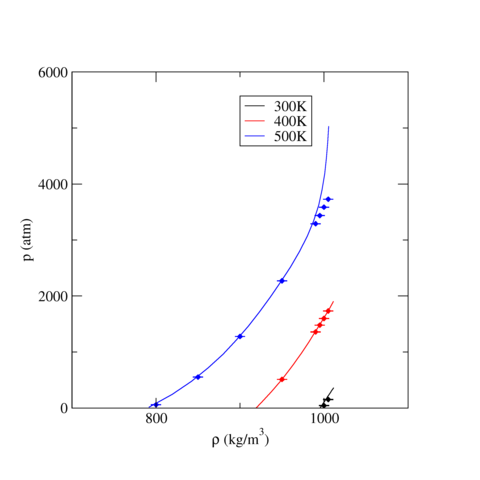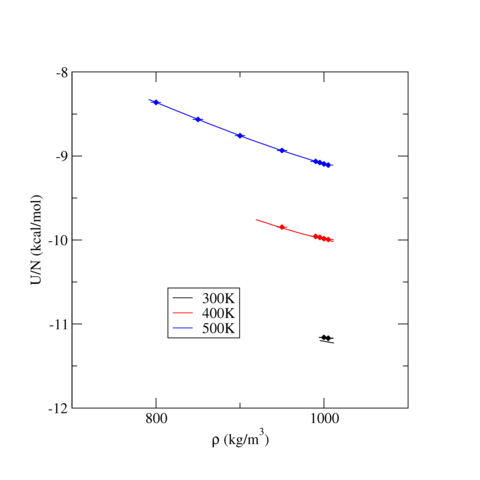LAMMPS MD: Equation of State (pressure vs. density) - SPC/E Water
The main purpose of the following data set is to present equation of state (density-pressure-temperature) data for a version of the SPC/E Water fluid that was obtained using the LAMMPS Molecular Dynamics (MD) simulation suite. The secondary purpose of this data set is to provide sample LAMMPS input and initial configuration files that an end user may use in LAMMPS to obtain the same equation of state data, to either verify output from an installation of LAMMPS or educate the user about the basic features of LAMMPS. We first present output from LAMMPS, and compare it to Monte-Carlo derived results, and then provide a tutorial on how to reproduce that same data using LAMMPS.
Simulation Details
| Simulation Package | LAMMPS - Jump to Installation Tutorial |
| Method | Canonical Ensemble (fixed N, V, T) Molecular Dynamics using the LAMMPS "nvt" ensemble option, with SHAKE constraints to preserve bond lengths and angles |
| Number of SPC/E Molecules | 1500 |
| Simulation Cell | Cubic cell, volume set with constant N=1500 to achieve desired reduced density |
| Truncation | Lennard-Jones Dispersion: 10 Å + analytic Long-range Corrections; Electrostatics: 10 Å + Long-range correction [either conventional Ewald or Particle-particle particle-Mesh (PPPM) Ewald] |
| Time Step | 1.0 fs |
| Thermostat | Temperature imposed via Nosé-Hoover chained thermostats (three, LAMMPS default) with Tdamp=100 fs |
| Simulation length | 1.1x106 time steps (intended as 105 equilibration steps followed by 106 production steps) |
Additional simulation details are in the sample input file, below.
Results
1. Results for Select Temperatures (Tabular)
| T = 300 K | T = 400 K | T = 500 K | ||||||||||
| ρ (kg/m3) | p (atm) | +/- | U/N (kcal/mol) | +/- | p (atm) | +/- | U/N (kcal/mol) | +/- | p (atm) | +/- | U/N (kcal/mol) | +/- |
| 800 | unstable | unstable | 5.790E+01 | 2.938E+00 | -8.362E+00 | 6.822E-04 | ||||||
| 850 | unstable | unstable | 5.521E+02 | 2.535E+00 | -8.565E+00 | 8.531E-04 | ||||||
| 900 | unstable | unstable | 1.277E+03 | 2.659E+00 | -8.758E+00 | 9.485E-04 | ||||||
| 950 | unstable | 5.109E+02 | 2.341E+00 | -9.847E+00 | 3.753E-04 | 2.270E+03 | 2.550E+00 | -8.934E+00 | 4.796E-04 | |||
| 990 | unstable | 1.358E+03 | 4.215E+00 | -9.957E+00 | 8.887E-04 | 3.290E+03 | 2.992E+00 | -9.064E+00 | 4.597E-04 | |||
| 995 | unstable | 1.479E+03 | 2.378E+00 | -9.969E+00 | 7.589E-04 | 3.432E+03 | 3.951E+00 | -9.078E+00 | 1.039E-03 | |||
| 1000 | 4.321E+01 | 5.118E+00 | -1.674E+01 | 1.770E-03 | 1.599E+03 | 2.865E+00 | -9.984E+00 | 1.050E-03 | 3.586E+03 | 2.888E+00 | -9.095E+00 | 7.933E-04 |
| 1005 | 1.519E+02 | 5.504E+00 | -1.117E+01 | 1.738E-03 | 1.732E+03 | 3.865E+00 | -9.994E+00 | 7.756E-04 | 3.728E+03 | 2.868E+00 | -9.108E+00 | 7.514E-04 |
2. Pressure-Density-Energy Equation of State
The following graphics show the pressure-density equations of state and the internal energy per molecule versus density in the form of a phase diagram for select temperatures (300, 400, and 500 K). In both graphics, the solid lines are the corresponding equation of state and energy as calculated from Grand Canonical-Transition Matrix Monte Carlo Simulations (GC-TMMC). Solid symbols indicate the results from LAMMPS simulations, with the standard error shown by error bars. There is relatively good agreement between the two sets of results, except for the isotherm at 500K, which is approaching the critical temperature, where system-size effects are expected to lead to disagreement between different techniques.


Reproducing Output
The LAMMPS MD results in the preceding table and graphics may be reproduced using example LAMMPS runs described as follows.
1. LAMMPS Installation
The data shown above were generated using a generic installation of LAMMPS, the executables of which may be reproduced as described here. This tutorial assumes some level of familiarity with POSIX-compliant operating systems (e.g., Unix, Linux, or Mac OSX) at the command-prompt level and access to a system with the GCC compiler, OpenMPI parallelization suite, Python, and the git version control system. This tutorial uses ">" to indicate the shell command prompt and $LAMMPS_DIR to identify the directory where LAMMPS is downloaded and later compiled. First, LAMMPS can be obtained using the instructions at https://lammps.sandia.gov/download.html#git via:
>git clone https://github.com/lammps/lammps.git
Second, LAMMPS executables may be compiled via:
>cd $LAMMPS_DIR >git checkout stable_31Mar2017 >cd src >make purge >make package-update >make yes-user-misc yes-molecule yes-rigid yes-kspace >make -j8 mpi
The installation sequence 1) switches to the "stable_31Mar2017" commit of LAMMPS (to ensure that a user is using the same code used to generate the data shown above), 2) removes any existing installation of LAMMPS, 3) updates any out of date packages, 4) installs the "USER-MISC", "MOLECULE", "RIGID", and "KSPACE" packages to enable the simulation of a rigid molecule using Ewald-type long-range electrostatics, and 5) builds an MPI-enabled executable using eight processor cores for parallel compilation. The end result is an executable named "lmp_mpi" located in the $LAMMPS_DIR/src directory.
Finally, we used the following operating system, compiler, and MPI libraries to build the LAMMPS executable:
Linux OS: CentOS 7; 3.10.0-514.21.1.el7.x86_64 kernel
GCC: v4.8.5 (2015-06-23, listed as Red Hat 4.8.5-11)
OpenMPI: v1.10.3 (2016-06-14)
LAMMPS: Git Checkout Tag stable_31Mar2017 (2017-03-31)
2. Example LAMMPS Scripts
Example LAMMPS scripts and initial configurations that will yield the data shown above may be obtained from a git repository at: https://github.com/dwsideriusNIST/LAMMPS_Examples, e.g. via:
>git clone git [at] github.com:dwsideriusNIST/LAMMPS_Examples.git
This tutorial assumes that the git repository resides in $EXAMPLES_DIR. The relevant inner directories are:
| SPCE_initial_cfgs | Initial configurations of N=1500 SPC/E molecules at the specified density i.e., spce_N1500_config.dens_800kgm3.lammps is an initial configuration at density ρ=800 kg/m3. |
| SPCE_reference_cfgs | Configurations of SPC/E molecules used for reference energy calculations. These configurations are identical to those used for Ewald summation reference calculations with a 9Å cutoff and a 10 Å cutoff. |
| run_scripts | Relevant LAMMPS Scripts |
| analysis | Python scripts to post-process LAMMPS output |
| SPCE_example | Example shell script that will run a LAMMPS simulation at ρ=1000 kg/m3 |
3. Example LAMMPS Run
A short example LAMMPS run is available in $EXAMPLES_DIR/SPCE_example, which may be run to confirm that LAMMPS is operating properly. This simulation is executed via:
>cd $EXAMPLES_DIR/SPCE_example >sh example.sh
In the "example.sh" script, this script runs an SPC/E simulation at ρ=1000 kg/m3 and T=300 K for 60000 time steps (all LAMMPS settings are as shown previously, using the Particle-particle Particle-mesh k-space option) then analyzes the MD trajectory to report the average temperature, pressure, and potential energy. The final output, from the block analysis script, will report the following ensemble averages and uncertainty:
Thermodynamic Ensemble Averages from: ave.dens_1000kgm3.out Discarded Timesteps: 10000 Number of Blocks: 5 Block size (timesteps): 10000 Stated uncertainty is the standard error of the thermodynamic propertyTemperature +3.0011E+02 +/- +1.5853E-01PotentialEnergy -1.6730E+04 +/- +8.4612E+00Pressure +3.6834E+01 +/- +2.9068E+01
4. SPC/E Reference Energy Calculations using LAMMPS
NIST provides reference energy calculations for SPC/E configuration elsewhere in the Standard Reference Simulation Website (9 Å cutoff and 10 Å cutoff); those calculations were made using a custom implementation of the Ewald summation. Here we provide a script that can recreate those reference calculations using LAMMPS, with some modifications. The git repository referenced earlier contains the four SPC/E configurations from the SPC/E reference calculations in LAMMPS format, as files spce_sample_config_periodic_cubicN.LAMMPS, with "N" replaced with 1, 2, 3, or 4. The energy of one of these configurations, using the 9 Å cutoff, may be computed via:
>cd $EXAMPLES_DIR >mkdir ref_energy ; cd ref_energy >cp ../run_scripts/SPCE.initial_energy ./ ; cp ../SPCE_reference_cfgs/spce_sample_config_periodic_cubic1.LAMMPS ./ >mpirun -np 12 lmp_mpi -in SPCE.initial_energy -var infile spce_sample_config_periodic_cubic1.LAMMPS| Configuration -> | 1 | 2 | 3 | 4 |
| Number of SPC/E Molecules | 100 | 200 | 300 | 750 |
| Pair Dispersion (kcal/mol) | 1.984342E+02 | 3.873873E+02 | 7.096428E+02 | 9.012683E+02 |
| Dispersion Long-range Correction (kcal/mol) | -2.244726E+00 | -8.978904E+00 | -2.020253E+01 | -3.741210E+01 |
| Real-space Coulombic (kcal/mol) | 4.473370E+03 | 8.797163E+03 | 1.285080E+04 | 2.126526E+04 |
| Fourier-space Coulombic (kcal/mol) | -5.640534E+03 | -1.129400E+04 | -1.694854E+04 | -2.824985E+04 |
| Total Energy (kcal/mol) | -9.709749E+02 | -2.118424E+03 | -3.408305E+03 | -6.120733E+03 |
The reference calculations for the 9Å cutoff are presented with more granularity (separation of the real-space and Fourier-space terms) and must be modified slightly for comparison with LAMMPS. Specifically, the LAMMPS Real-space Coulombic term is equal to Ereal + Eintra and the LAMMPS Fourier-space Coulombic term is equal to Efourier + Eself. Also, the units must be converted from Kelvin units to kcal/mol, which was done using the CODATA 2010 set of physical properties. The results are shown in Table 2.
Table 2: SPC/E reference energies from "SPC/E Water Reference Calculations - 9Å cutoff", converted to LAMMPS-equivalent terms and units.
| Configuration -> | 1 | 2 | 3 | 4 |
| Number of SPC/E Molecules | 100 | 200 | 300 | 750 |
| Pair Dispersion (kcal/mol) | 1.984342E+02 | 3.873874E+02 | 7.096430E+02 | 9.012686E+02 |
| Dispersion Long-range Correction (kcal/mol) | -2.244727E+00 | -8.978906E+00 | -2.020254E+01 | -3.741211E+01 |
| Real-space Coulombic (kcal/mol) | 4.473373E+03 | 8.797168E+03 | 1.285080E+04 | 2.126529E+04 |
| Fourier-space Coulombic (kcal/mol) | -5.640523E+03 | -1.129397E+04 | -1.694853E+04 | -2.824984E+04 |
| Total Energy (kcal/mol) | -9.709607E+02 | -2.118396E+03 | -3.408283E+03 | -6.120694E+03 |
There are minor differences between the two sets of calculations, which follow from 1) different truncation schemes for physical parameters, 2) different implementations of the complementary error function, 3) different strategies for selecting the number of k-vectors, and 4) floating-point precision.
5. Production LAMMPS Runs
>mpirun -np $NP lmp_mpi -in SPCE.NVT -var infile $FOO -var temp $BAR >$EXAMPLES_DIR/analysis/block_analysis.py -f $FILENAME -b $BLOCKS -m $STEPS_SKIP >cd $EXAMPLES_DIR >mkdir test ; cd test >cp ../run_scripts/SPCE.NVT ./ ; cp ../SPCE_initial_cfgs/spce_N1500_config.dens_1000kgm3.lammps ./ >mpirun -np 12 lmp_mpi -in SPCE.NVT -var infile spce_N1500_config.dens_900kgm3.lammps -var temp 300.0 >../analysis/block_analysis.py -f ave.out -b 10 -m 100000Thermodynamic Ensemble Averages from: ave.out Discarded Timesteps: 100000 Number of Blocks: 10 Block size (timesteps): 100000 Stated uncertainty is the standard error of the thermodynamic propertyTemperature +2.9998E+02 +/- +2.8905E-02PotentialEnergy -1.6744E+04 +/- +1.7701E+00Pressure +4.3206E+01 +/- +5.1179E+00
Contacts
-
(301) 975-5968

